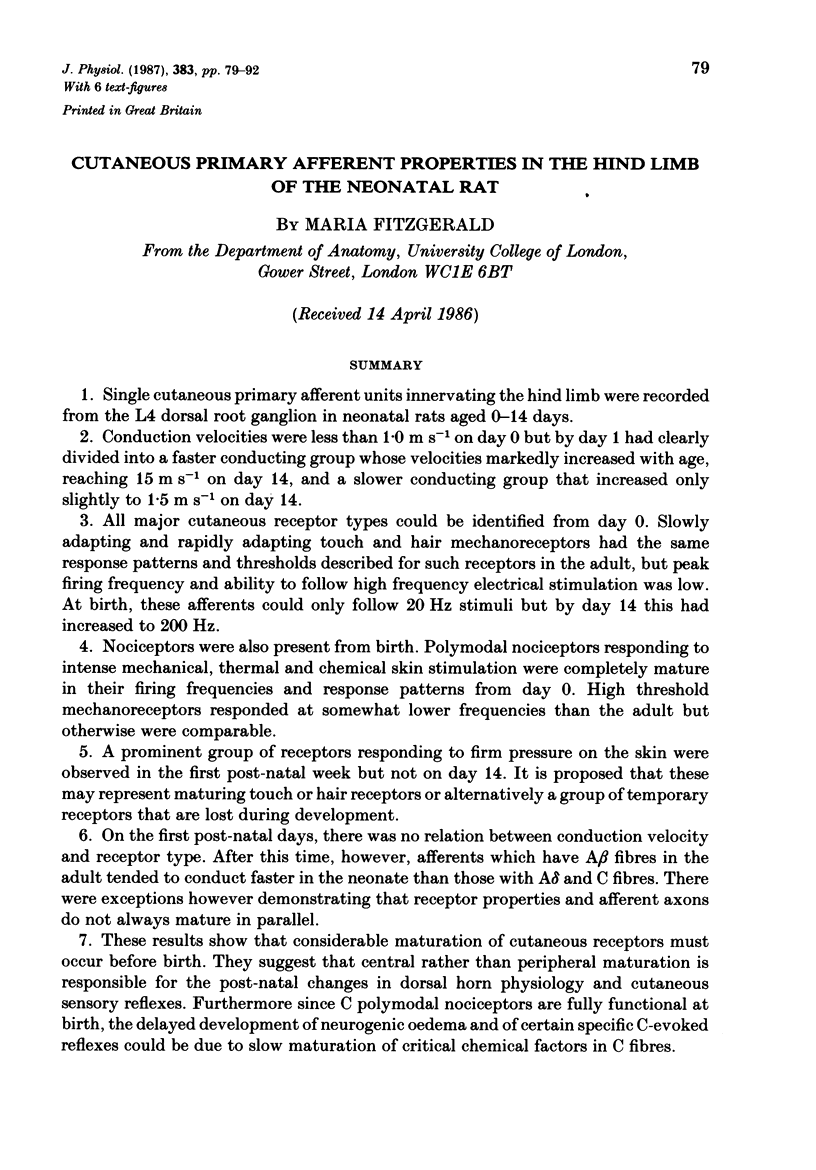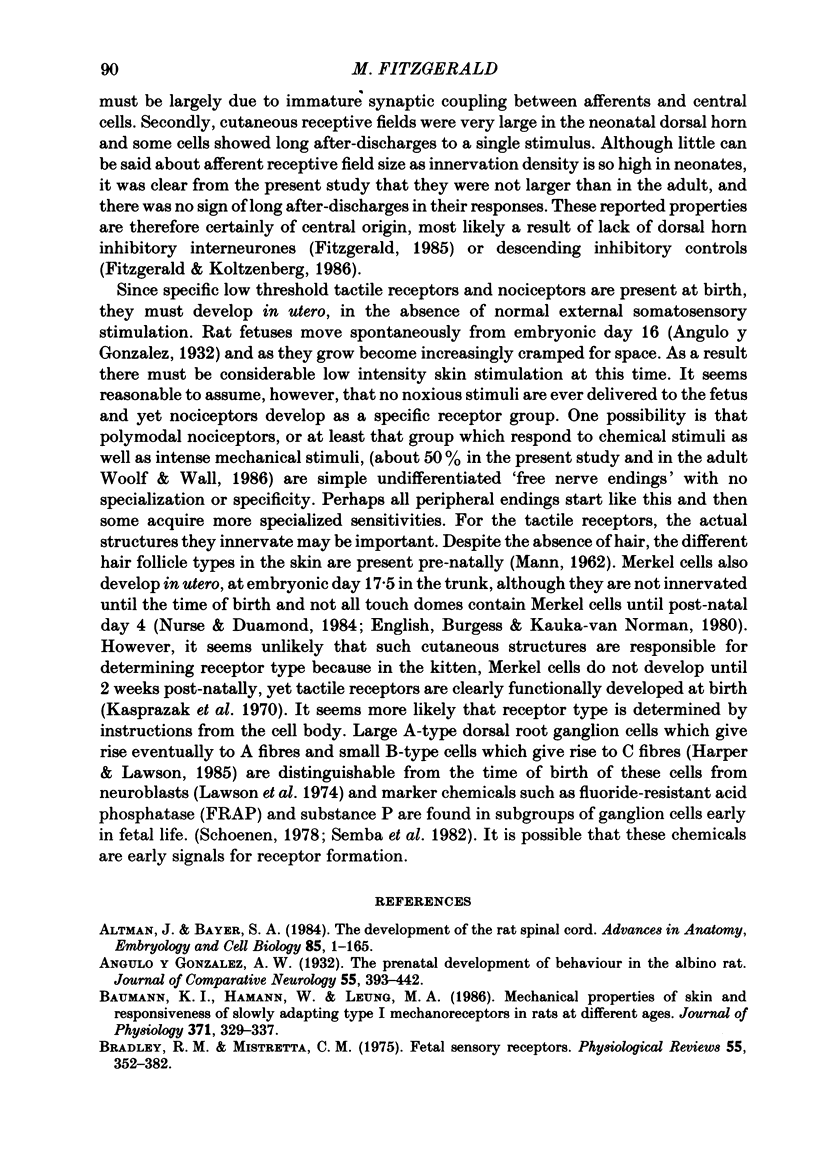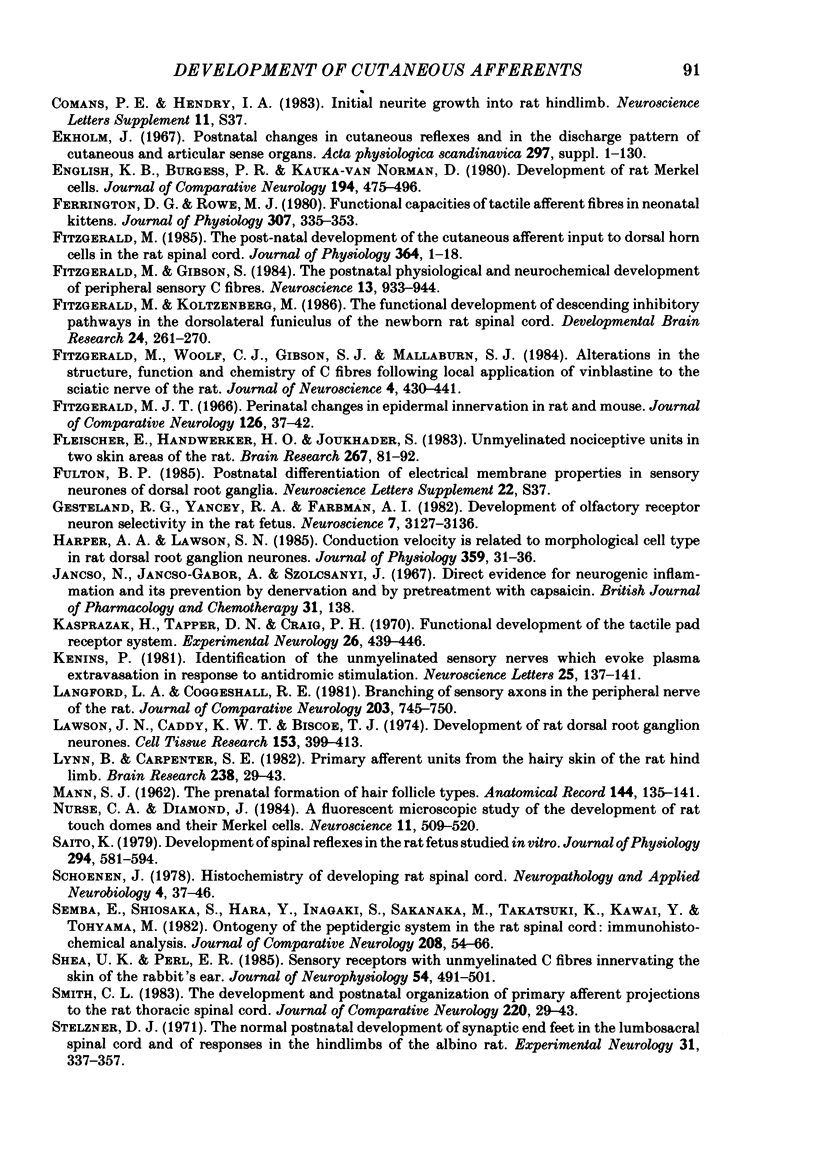Abstract
1. Single cutaneous primary afferent units innervating the hind limb were recorded from the L4 dorsal root ganglion in neonatal rats aged 0-14 days. 2. Conduction velocities were less than 1.0 m s-1 on day 0 but by day 1 had clearly divided into a faster conducting group whose velocities markedly increased with age, reaching 15 m s-1 on day 14, and a slower conducting group that increased only slightly to 1.5 m s-1 on day 14. 3. All major cutaneous receptor types could be identified from day 0. Slowly adapting and rapidly adapting touch and hair mechanoreceptors had the same response patterns and thresholds described for such receptors in the adult, but peak firing frequency and ability to follow high frequency electrical stimulation was low. At birth, these afferents could only follow 20 Hz stimuli but by day 14 this had increased to 200 Hz. 4. Nociceptors were also present from birth. Polymodal nociceptors responding to intense mechanical, thermal and chemical skin stimulation were completely mature in their firing frequencies and response patterns from day 0. High threshold mechanoreceptors responded at somewhat lower frequencies than the adult but otherwise were comparable. 5. A prominent group of receptors responding to firm pressure on the skin were observed in the first post-natal week but not on day 14. It is proposed that these may represent maturing touch or hair receptors or alternatively a group of temporary receptors that are lost during development. 6. On the first post-natal days, there was no relation between conduction velocity and receptor type. After this time, however, afferents which have A beta fibres in the adult tended to conduct faster in the neonate than those with A delta and C fibres. There were exceptions however demonstrating that receptor properties and afferent axons do not always mature in parallel. 7. These results show that considerable maturation of cutaneous receptors must occur before birth. They suggest that central rather than peripheral maturation is responsible for the post-natal changes in dorsal horn physiology and cutaneous sensory reflexes. Furthermore since C polymodal nociceptors are fully functional at birth, the delayed development of neurogenic oedema and of certain specific C-evoked reflexes could be due to slow maturation of critical chemical factors in C fibres.
Full text
PDF













Selected References
These references are in PubMed. This may not be the complete list of references from this article.
- Baumann K. I., Hamann W., Leung M. S. Mechanical properties of skin and responsiveness of slowly adapting type I mechanoreceptors in rats at different ages. J Physiol. 1986 Feb;371:329–337. doi: 10.1113/jphysiol.1986.sp015978. [DOI] [PMC free article] [PubMed] [Google Scholar]
- Bradley R. M., Mistretta C. M. Fetal sensory receptors. Physiol Rev. 1975 Jul;55(3):352–382. doi: 10.1152/physrev.1975.55.3.352. [DOI] [PubMed] [Google Scholar]
- Ekholm J. Postnatal changes in cutaneous reflexes and in the discharge pattern of cutaneous and articular sense organs. A morphological and physiological study in the cat. Acta Physiol Scand Suppl. 1967;297:1–130. [PubMed] [Google Scholar]
- English K. B., Burgess P. R., Kavka-Van Norman D. Development of rat Merkel cells. J Comp Neurol. 1980 Nov 15;194(2):475–496. doi: 10.1002/cne.901940212. [DOI] [PubMed] [Google Scholar]
- Ferrington D. G., Rowe M. J. Functional capacities of tactile afferent fibres in neonatal kittens. J Physiol. 1980 Oct;307:335–353. doi: 10.1113/jphysiol.1980.sp013438. [DOI] [PMC free article] [PubMed] [Google Scholar]
- Fitzgerald M. J. Perinatal changes in epidermal innervation in rat and mouse. J Comp Neurol. 1966 Jan;126(1):37–41. doi: 10.1002/cne.901260103. [DOI] [PubMed] [Google Scholar]
- Fitzgerald M., Gibson S. The postnatal physiological and neurochemical development of peripheral sensory C fibres. Neuroscience. 1984 Nov;13(3):933–944. doi: 10.1016/0306-4522(84)90107-6. [DOI] [PubMed] [Google Scholar]
- Fitzgerald M., Koltzenburg M. The functional development of descending inhibitory pathways in the dorsolateral funiculus of the newborn rat spinal cord. Brain Res. 1986 Jan;389(1-2):261–270. doi: 10.1016/0165-3806(86)90194-x. [DOI] [PubMed] [Google Scholar]
- Fitzgerald M. The post-natal development of cutaneous afferent fibre input and receptive field organization in the rat dorsal horn. J Physiol. 1985 Jul;364:1–18. doi: 10.1113/jphysiol.1985.sp015725. [DOI] [PMC free article] [PubMed] [Google Scholar]
- Fitzgerald M., Woolf C. J., Gibson S. J., Mallaburn P. S. Alterations in the structure, function, and chemistry of C fibers following local application of vinblastine to the sciatic nerve of the rat. J Neurosci. 1984 Feb;4(2):430–441. doi: 10.1523/JNEUROSCI.04-02-00430.1984. [DOI] [PMC free article] [PubMed] [Google Scholar]
- Fleischer E., Handwerker H. O., Joukhadar S. Unmyelinated nociceptive units in two skin areas of the rat. Brain Res. 1983 May 9;267(1):81–92. doi: 10.1016/0006-8993(83)91041-7. [DOI] [PubMed] [Google Scholar]
- Gesteland R. C., Yancey R. A., Farbman A. I. Development of olfactory receptor neuron selectivity in the rat fetus. Neuroscience. 1982;7(12):3127–3136. doi: 10.1016/0306-4522(82)90235-4. [DOI] [PubMed] [Google Scholar]
- Harper A. A., Lawson S. N. Conduction velocity is related to morphological cell type in rat dorsal root ganglion neurones. J Physiol. 1985 Feb;359:31–46. doi: 10.1113/jphysiol.1985.sp015573. [DOI] [PMC free article] [PubMed] [Google Scholar]
- Jancsó N., Jancsó-Gábor A., Szolcsányi J. Direct evidence for neurogenic inflammation and its prevention by denervation and by pretreatment with capsaicin. Br J Pharmacol Chemother. 1967 Sep;31(1):138–151. doi: 10.1111/j.1476-5381.1967.tb01984.x. [DOI] [PMC free article] [PubMed] [Google Scholar]
- Kasprzak H., Tapper D. N., Craig P. H. Functional development of the tactile pad receptor system. Exp Neurol. 1970 Mar;26(3):439–446. doi: 10.1016/0014-4886(70)90140-8. [DOI] [PubMed] [Google Scholar]
- Kenins P. Identification of the unmyelinated sensory nerves which evoke plasma extravasation in response to antidromic stimulation. Neurosci Lett. 1981 Sep 1;25(2):137–141. doi: 10.1016/0304-3940(81)90321-9. [DOI] [PubMed] [Google Scholar]
- Langford L. A., Coggeshall R. E. Branching of sensory axons in the peripheral nerve of the rat. J Comp Neurol. 1981 Dec 20;203(4):745–750. doi: 10.1002/cne.902030411. [DOI] [PubMed] [Google Scholar]
- Lawson S. N., Caddy K. W., Biscoe T. J. Development of rat dorsal root ganglion neurones. Studies of cell birthdays and changes in mean cell diameter. Cell Tissue Res. 1974;153(3):399–413. doi: 10.1007/BF00229167. [DOI] [PubMed] [Google Scholar]
- Lynn B., Carpenter S. E. Primary afferent units from the hairy skin of the rat hind limb. Brain Res. 1982 Apr 22;238(1):29–43. doi: 10.1016/0006-8993(82)90768-5. [DOI] [PubMed] [Google Scholar]
- Nurse C. A., Diamond J. A fluorescent microscopic study of the development of rat touch domes and their Merkel cells. Neuroscience. 1984 Feb;11(2):509–520. doi: 10.1016/0306-4522(84)90041-1. [DOI] [PubMed] [Google Scholar]
- Schoenen J. Histoenzymology of the developing rat spinal cord. Neuropathol Appl Neurobiol. 1978 Jan-Feb;4(1):37–46. doi: 10.1111/j.1365-2990.1978.tb00527.x. [DOI] [PubMed] [Google Scholar]
- Senba E., Shiosaka S., Hara Y., Inagaki S., Sakanaka M., Takatsuki K., Kawai Y., Tohyama M. Ontogeny of the peptidergic system in the rat spinal cord: immunohistochemical analysis. J Comp Neurol. 1982 Jun 10;208(1):54–66. doi: 10.1002/cne.902080105. [DOI] [PubMed] [Google Scholar]
- Shea V. K., Perl E. R. Sensory receptors with unmyelinated (C) fibers innervating the skin of the rabbit's ear. J Neurophysiol. 1985 Sep;54(3):491–501. doi: 10.1152/jn.1985.54.3.491. [DOI] [PubMed] [Google Scholar]
- Smith C. L. The development and postnatal organization of primary afferent projections to the rat thoracic spinal cord. J Comp Neurol. 1983 Oct 10;220(1):29–43. doi: 10.1002/cne.902200105. [DOI] [PubMed] [Google Scholar]
- Stelzner D. J. The normal postnatal development of synaptic end-feet in the lumbosacral spinal cord and of responses in the hind limbs of the albino rat. Exp Neurol. 1971 Jun;31(3):337–357. doi: 10.1016/0014-4886(71)90237-8. [DOI] [PubMed] [Google Scholar]
- Wiesel T. N. Postnatal development of the visual cortex and the influence of environment. Nature. 1982 Oct 14;299(5884):583–591. doi: 10.1038/299583a0. [DOI] [PubMed] [Google Scholar]
- Woolf C. J., Wall P. D. Relative effectiveness of C primary afferent fibers of different origins in evoking a prolonged facilitation of the flexor reflex in the rat. J Neurosci. 1986 May;6(5):1433–1442. doi: 10.1523/JNEUROSCI.06-05-01433.1986. [DOI] [PMC free article] [PubMed] [Google Scholar]


